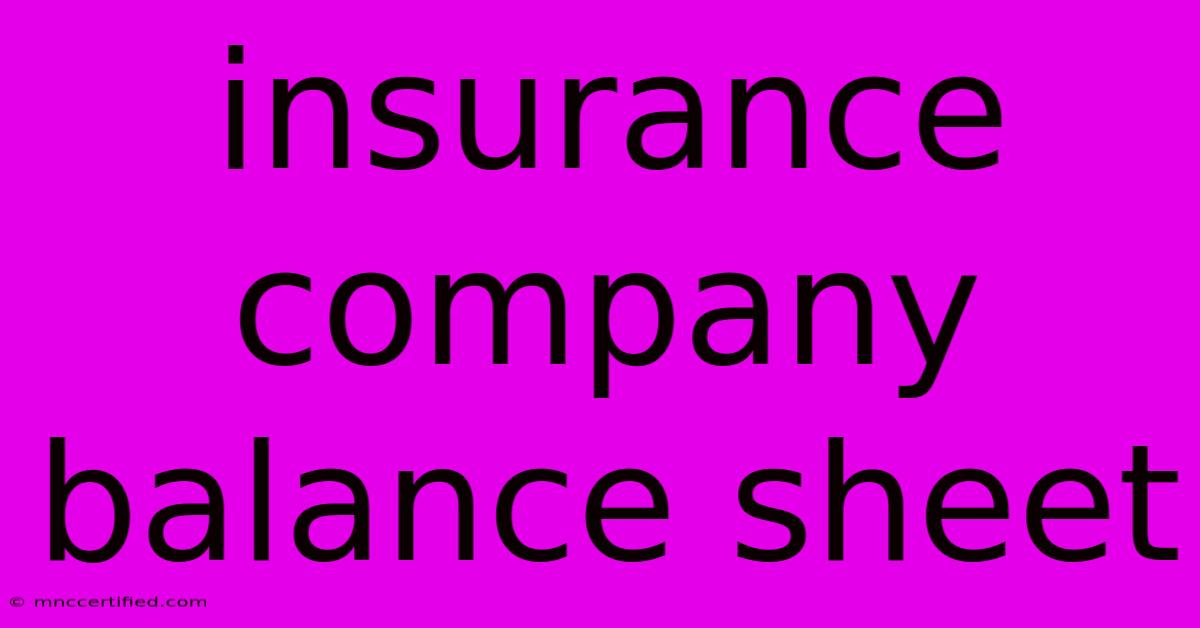Insurance Company Balance Sheet

Table of Contents
Decoding the Insurance Company Balance Sheet: A Comprehensive Guide
Understanding an insurance company's financial health is crucial for investors, policyholders, and regulators alike. The insurance company balance sheet, unlike a typical corporate balance sheet, reflects the unique nature of the insurance business – managing risk and long-term liabilities. This guide will break down the key components, offering insights into what to look for and how to interpret the information presented.
Key Components of an Insurance Company Balance Sheet
The balance sheet follows the fundamental accounting equation: Assets = Liabilities + Equity. Let's delve into each component specific to the insurance industry:
Assets
Insurance company assets are categorized to reflect the nature of their investments and the liquidity needed to meet claims obligations. Key asset categories include:
-
Investments: This is usually the largest portion of an insurance company's assets. It comprises bonds, stocks, real estate, mortgages, and other investment vehicles designed to generate returns and cover future claims. Analyzing the quality and diversification of these investments is critical. A portfolio heavily weighted in high-risk assets could signal potential financial instability. Look for a well-diversified portfolio with a mix of high-quality, low-risk and higher-yield investments.
-
Cash and Cash Equivalents: This represents the company's readily available funds to meet immediate obligations, such as paying claims and operating expenses. A healthy cash position indicates liquidity and financial stability. A low cash balance relative to liabilities might raise concerns.
-
Premiums Receivable: This asset represents premiums owed to the company but not yet received from policyholders. A significant increase in premiums receivable might indicate collection challenges.
-
Reinsurance Recoverables: This refers to amounts the company expects to recover from reinsurers for claims already paid. Reinsurance is a crucial risk management tool for insurance companies, and these recoverables represent a crucial aspect of their financial position.
Liabilities
Liabilities represent the insurance company's financial obligations. Understanding the nature and size of these obligations is vital for assessing the company's solvency:
-
Reserves: This is the most significant liability for an insurance company. Reserves represent the estimated amount needed to pay future claims on existing policies. Adequately reserving for future claims is crucial for long-term stability. Actuaries play a key role in determining reserve levels, and their methodologies should be scrutinized. Under-reserving can lead to insolvency, while over-reserving can reduce profitability.
-
Unearned Premiums: This represents the portion of premiums received that covers future policy periods. It's a liability because the company hasn't yet earned the right to keep the full amount.
-
Other Liabilities: This category encompasses various obligations such as unpaid expenses, taxes payable, and debt.
Equity (or Policyholder Surplus)
Equity represents the difference between an insurance company's assets and its liabilities. In the insurance context, it's often referred to as policyholder surplus. This is a crucial indicator of the company's financial strength and ability to absorb losses. A higher policyholder surplus generally indicates greater financial stability.
Analyzing the Insurance Company Balance Sheet: Key Ratios
Several key ratios can help in analyzing the health of an insurance company based on its balance sheet:
-
Combined Ratio: This measures the company's underwriting profitability. A combined ratio below 100% indicates underwriting profit, while above 100% signifies a loss.
-
Policyholder Surplus Ratio: This ratio compares policyholder surplus to net written premiums, indicating the company's capacity to absorb losses. A higher ratio generally suggests better financial strength.
-
Asset-Liability Matching: This assessment focuses on whether the company's assets are sufficiently liquid to meet its liabilities as they mature. Mismatches can lead to liquidity problems.
Importance of Understanding the Insurance Company Balance Sheet
Understanding the insurance company balance sheet is crucial for:
- Investors: To assess the financial health and potential investment risks.
- Policyholders: To gauge the insurer's ability to pay future claims.
- Regulators: To ensure the solvency and stability of the insurance industry.
By carefully analyzing the balance sheet and related ratios, stakeholders can gain valuable insights into the financial strength and stability of insurance companies, making informed decisions about investments, policy selection, and regulatory oversight. Remember to consider the balance sheet in conjunction with other financial statements, such as the income statement and cash flow statement, for a complete picture.

Thank you for visiting our website wich cover about Insurance Company Balance Sheet. We hope the information provided has been useful to you. Feel free to contact us if you have any questions or need further assistance. See you next time and dont miss to bookmark.
Featured Posts
-
2023 Signing Joins West Ham First Team Training
Nov 26, 2024
-
Car Insurance In Winter Park Fl
Nov 26, 2024
-
Erie Insurance Conneautville Pa
Nov 26, 2024
-
Eli Apple Back On Active Roster
Nov 26, 2024
-
Man Arrested After Ladbroke Grove Shooting
Nov 26, 2024